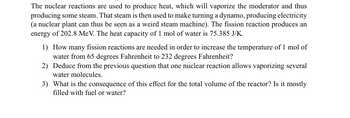Question

Transcribed Image Text:The nuclear reactions are used to produce heat, which will vaporize the moderator and thus
producing some steam. That steam is then used to make turning a dynamo, producing electricity
(a nuclear plant can thus be seen as a weird steam machine). The fission reaction produces an
energy of 202.8 MeV. The heat capacity of 1 mol of water is 75.385 J/K.
1) How many fission reactions are needed in order to increase the temperature of 1 mol of
water from 65 degrees Fahrenheit to 232 degrees Fahrenheit?
2) Deduce from the previous question that one nuclear reaction allows vaporizing several
water molecules.
3) What is the consequence of this effect for the total volume of the reactor? Is it mostly
filled with fuel or water?
Expert Solution
This question has been solved!
Explore an expertly crafted, step-by-step solution for a thorough understanding of key concepts.
Step by stepSolved in 2 steps

Knowledge Booster
Similar questions
- 9 H the mass of the products in a fission reaction is 3.2 x 10^28 kg less than the reactants, how much energy is released in the reaction? (A) 3.6 10 45J (B) 1.1 x 10-38J (C) 9.6 x 10420 J (D) 2.9 x 10-11 Jarrow_forwardA proposed nuclear reactor facility will have an electrical power output of 908 MW with a 31.3% efficiency in converting nuclear to electrical power. Assuming the average fission reaction produces 234 MeV, how many reactions will take place at the facility every second?arrow_forwardUranium-235 is used as a nuclear fuel for Canadian made CANDU nuclear power plants. During one such fission reaction, a uranium-235 atom is split by a fast moving neutron to produce krypton-92, barium-141 and an unknown number of neutrons. Determine the number of neutrons produced by this reaction, record that value in blank #1. Determine the energy released by the reaction, rounded to the nearest whole MeV, record that in blank #2. Isotope Uranium-235 Krypton-92 Barium-141 Neutron Mass (u) 235.043930 91.92345 140.91440 1.008665arrow_forward
- In the following fission reaction, identify the other product: 235:92 U + 1:0 n → 139:53 I + 2 1:0 n + __________arrow_forwardOn absorption of a single neutron, plutonium Pu-239 can undergo fission into xenon Xe-134 plus zirconium Zr-103 plus three neutrons. The masses of these nuclei are, mpu-239 = 239.052 amu, mxe-134 = 133.905 amu, and mzr-103 = 102.927 amu. Calculate the energy given off in this nuclear reaction.arrow_forward(a) Show that about 1.0 × 1010 J would be released by the fusion of the deuterons in 1.0 gal of water. Note that 1 of every 6 500 hydrogen atoms is a deuteron. (b) The average energy consumption rate of a person living in the United States is about 1.0 × 104 J/s (an average power of 10 kW). At this rate, how long would the energy needs of one person be supplied by the fusion of the deuterons in 1.0 gal of water? Assume the energy released per deuteron is 1.64 MeVarrow_forward
arrow_back_ios
arrow_forward_ios